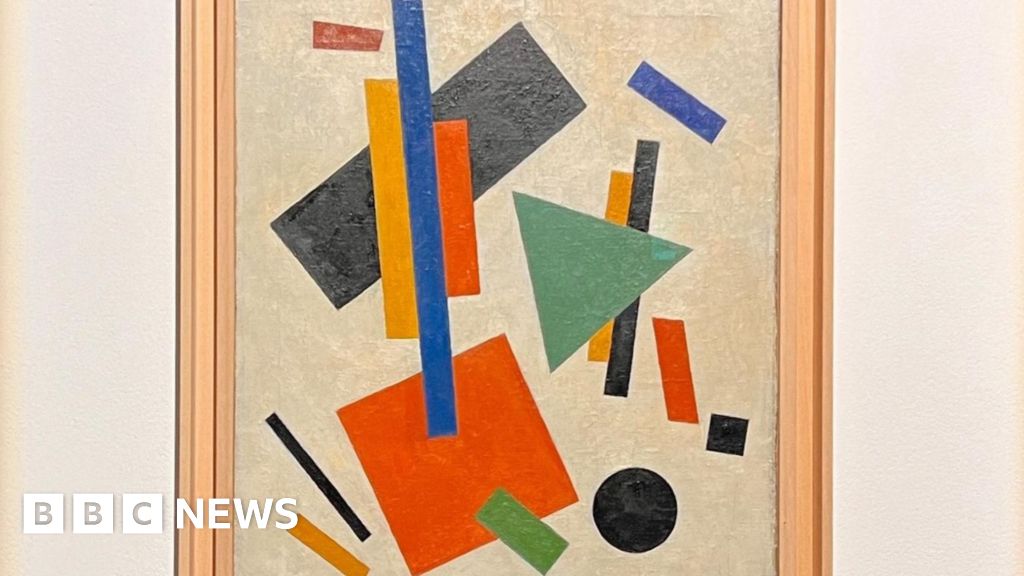Were masterpieces worth £100m really found under a pensioner's bed?

```html Doubts Cast on £100m Malevich Paintings Found Under Pensioner's Bed
Three previously unseen oil paintings, attributed to the renowned avant-garde artist Kazimir Malevich and potentially worth over £100 million, are currently on display at Romania's National Museum of Contemporary Art (MNAC) in Bucharest. However, the art world is expressing significant skepticism regarding their authenticity, fueled by concerns about their provenance and supporting documentation.
A Lucrative Discovery, A Contentious History
The paintings, titled "Suprematist Composition with Green and Black Rectangle" (1918), "Cubofuturist Composition" (1912–13), and "Suprematist Composition with Red Square and Green Triangle" (1915–16), reportedly surfaced during a house move in 2023. According to Yaniv Cohen, an Israeli businessman and owner of the works, they were discovered under the mattress of his wife's grandmother, Eva Levando, an Israeli pensioner who had emigrated from Soviet Ukraine. Levando allegedly inherited the paintings from her father, an accountant in Odesa, who purportedly acquired one and received the other two as payment for services rendered.
Art World Skepticism and Missing Provenance
Despite the exhibition, experts remain unconvinced. Konstantin Akinsha, a Ukrainian-American art historian and curator, has raised serious doubts about the paintings' documented history. "The three works now exhibited in Bucharest were not documented, photographed, or shown during the artist's lifetime," Akinsha told the BBC, highlighting the lack of records tracing them back to Malevich's studio. He argues that the absence of such documentation is highly unusual for works of this significance and era.
Akinsha further points out the lack of evidence of Malevich's works circulating within the Russian or Ukrainian art markets during the late 1920s and early 1930s, a period relevant to the alleged acquisition by Levando's father. He also noted that Malevich's records do not mention any private sales after 1917, further complicating the narrative.
The Stalinist Era Explanation
Cohen attributes the lack of historical records to the Stalinist-era repression of modernist art, a period when many such works were suppressed or destroyed. While this historical context is valid, experts argue that it doesn't fully explain the complete absence of any prior documentation for these specific paintings.
Conflicting Expert Opinions and Technical Analysis
To support his claim, Cohen presented certificates from Kyiv art historian Dmytro Horbachov, who described the works as "first-class examples" of Malevich's style, based on his analysis of their technique and style. However, Horbachov's credibility has been questioned, as he has previously authenticated disputed works, including one reportedly removed from Vienna's Albertina Museum due to authenticity concerns.
Furthermore, while Horbachov claims to consult for Sotheby's and Christie's, both auction houses have denied any formal association with him. This discrepancy further fuels the skepticism surrounding the paintings' authenticity.
Technical Analysis Inconclusive
Technical analysis conducted by laboratories in Paris and Germany dated the pigments used in the paintings to Malevich's lifetime. However, these reports stopped short of attributing the works to the artist. Notably, reports from these same laboratories were previously associated with paintings later proven to be forgeries in a BBC documentary, "The Zaks Affair: Anatomy of a Fake Collection." Erhard Jägers of the German laboratory clarified that technical analysis alone cannot definitively prove a painting's authenticity.
Museum Distances Itself, Market Concerns Persist
Following Akinsha's questioning of the paintings' provenance, the MNAC issued a statement characterizing the exhibition as "a curatorial experiment." The museum emphasized that it lacks expertise in authenticating the works and relied solely on the documents provided by Cohen. The MNAC explicitly stated that including the paintings in the exhibition "should not be interpreted as institutional validation of their authorship or authenticity."
A "Tip of the Iceberg" in a Fraught Market
Konstantin Akinsha believes that publicly known cases of disputed works by Malevich and other artists of the period represent only "the tip of the iceberg." He suggests that "thousands of questionable works continue to circulate today."
Reto Barmettler, a consultant on Russian paintings with Sotheby's, echoed this sentiment, stating that the market for Russian and Ukrainian modernist art is rife with "obviously problematic" works. He emphasizes the importance of documented provenance and exhibition history in establishing the authenticity of avant-garde paintings. "Good avant-garde paintings don't come out of nowhere - they are of obvious quality, come with documented provenance and, ideally, an exhibition history," Barmettler explained, although he refrained from commenting directly on Cohen's paintings.
The Uncertainty Remains
The exhibition of these three contested Malevich paintings highlights the complexities and challenges within the art market, particularly concerning works from periods of political upheaval and suppression. Until verifiable documentation emerges, the authenticity of these paintings and their true value will remain a subject of intense debate. ```
Originally sourced from: BBC Entertainment
